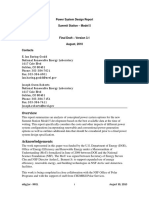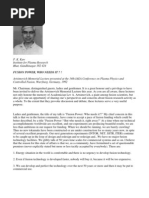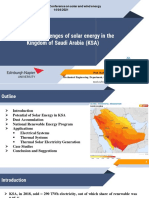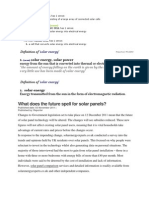Sample For Instructor Manual For Energy Systems Engineering 3rd Edition by Vanek and Albright
Sample For Instructor Manual For Energy Systems Engineering 3rd Edition by Vanek and Albright
Uploaded by
hadi farzinCopyright:
Available Formats
Sample For Instructor Manual For Energy Systems Engineering 3rd Edition by Vanek and Albright
Sample For Instructor Manual For Energy Systems Engineering 3rd Edition by Vanek and Albright
Uploaded by
hadi farzinOriginal Title
Copyright
Available Formats
Share this document
Did you find this document useful?
Is this content inappropriate?
Copyright:
Available Formats
Sample For Instructor Manual For Energy Systems Engineering 3rd Edition by Vanek and Albright
Sample For Instructor Manual For Energy Systems Engineering 3rd Edition by Vanek and Albright
Uploaded by
hadi farzinCopyright:
Available Formats
Contact me on WhatsApp in order to access full file: https://wa.
me/message/2H3BV2L5TTSUF1
Also, you can contact me on Email to access full vesrion Solution Manual: solution9159@gmail.com
Solutions to exercises
Chapter 1 Introduction
Short answers:
1.1 Open-ended discussion question; see below.
1.2 Open-ended discussion question; see below.
1.3 HDI = 0.736; not in line with other countries
1.4 (a) see figure, (b) discussion question, (c) R2 = 0.457, (d) R2 = 0.0241, (e) and (f)
discussion questions
1.5 33.9, 29.5, 18.9, 23.0 EJ
1.6 98.6, 22.5, 38.8, 13.6 quads
1.7 Rank order: India, China, United States, Japan
1.8 140.4, 248, 22.3, 30.8, 81.9 mtoe
1.9 See explanation below.
Detailed answers:
1.1. Use the Internet or other resources to chart the development of an energy technology, from
its earliest beginnings to the present day. Did the roots of this technology first emerge prior to the
start of the industrial revolution? If so, how? If not, when did the technology first emerge? In
what ways did the industrial revolution accelerate the growth of the technology? More recently,
what has been the impact of the information age (e.g., computers, software, electronically
controlled operation, the Internet, etc.) on the technology?
Answer: A variety of answers are possible. For example, for wind energy, the
roots of the technology predate the industrial revolution, dating back to the
middle ages in Europe and earlier to use of wind for grinding grain in China and
the Middle East. The industrial revolution made possible metallurgical
techniques, which in turn enabled the precision fabrication of turbine blades,
electrical components, etc., used in wind electric conversion devices. Since the
1970s, information technology has been used computationally to improve the
shape of the turbine blades or operationally to integrate electricity from the
turbine into the grid.
Alternatively, for solar energy: solar energy predates the industrial revolution, in
that the use of passive solar design to heat buildings or keep them cool goes back
to the Ancient Greeks, the Chinese, and the Native Americans of the southwest.
Also, solar drying of clothes and food has been practiced since antiquity. The
industrial revolution accelerated the growth of solar energy by making possible
metallurgical techniques, which in turn enabled the precision fabrication of
experimental solar-powered, steam-driven devices starting in the late 1800s.
They also made possible home-sized solar water heating systems for domestic
Instructor use only, not for student use 15
Contact me on WhatsApp in order to access full file: https://wa.me/message/2H3BV2L5TTSUF1
Also, you can contact me on Email to access full vesrion Solution Manual: solution9159@gmail.com
hot water. Since the 1970s, information technology has been used
computationally to control the manufacture of solar panels, or to operate tracking
systems that optimize the position of solar panels relative to the sun.
1.2. Note to instructors: it may be preferable to provide the students with the raw data for
the three countries used in this exercise, if you wish to save them time on the data
gathering and focus on the calculations and analysis.
Solution: From studying the accompanying graphs, it is clear that the trend in the United
Kingdom more closely resembles that of the United States than that of China.
On the GDP side, both the United States and the United Kingdom have gradually been
decreasing energy and CO2 emissions per unit of GDP produced, although the United
Kingdom is somewhat more efficient than the United States in producing a unit of GDP.
This is different from China, which saw dramatic reductions in energy and CO2 emissions
per unit of GDP between 1980 and 2000, although these are perhaps slowing after 2000.
On the population side, energy consumption per capita is slightly up for the United
Kingdom and the United States and CO2 emissions per capita are slightly down for the
period in question. This suggests that both countries are reducing the amount of CO2 per
unit of energy consumed. China is much lower in per capita measures than the other two
countries, but is seeing an upturn in both since 2000, so that it appears that in the most
recent years, China is moving in a different direction than the other two countries. Since
1995 or so, China is growing a much larger middle class, so it is not surprising that
energy and CO2 might turn upward in this way.
In general, the shape of the figures varies little whether one compares the three countries
in terms of per unit of energy or per unit of CO2 emitted. The most profound change has
been the reduction in energy and CO2 per unit of economic activity in China. Compared
to this trend, all other measures have not changed as much.
Figures to accompany Problem 1.2:
Instructor use only, not for student use 16
Contact me on WhatsApp in order to access full file: https://wa.me/message/2H3BV2L5TTSUF1
Also, you can contact me on Email to access full vesrion Solution Manual: solution9159@gmail.com
120.0
100.0
80.0
GJ/$GDP
China
60.0 UK
USA
40.0
20.0
0.0
1980 1985 1990 1995 2000 2004
9.0
8.0
7.0
6.0
kgCO2/$GDP
5.0 China
UK
4.0 USA
3.0
2.0
1.0
0.0
1980 1985 1990 1995 2000 2004
Instructor use only, not for student use 17
Contact me on WhatsApp in order to access full file: https://wa.me/message/2H3BV2L5TTSUF1
Also, you can contact me on Email to access full vesrion Solution Manual: solution9159@gmail.com
400.0
350.0
300.0
250.0
GJ/capita
China
200.0 UK
USA
150.0
100.0
50.0
0.0
1980 1985 1990 1995 2000 2004
25.0
20.0
tonneCO2/cap
15.0
China
UK
USA
10.0
5.0
0.0
1980 1985 1990 1995 2000 2004
1.3. The country of Fictionland has 31 million populations and consumes on average
12.09 exajoule (EJ), or 11.46 quads, of energy per year. The life expectancy of
Fictionland is 63 years, and the GDP per capita, on a PPP basis, is $13,800. The adult
literacy rate is 75%. The eligible and actual student enrollments for primary, secondary,
and college/university levels of education are given in the table below:
Eligible Enrolled
Primary 2,500,000 2,375,000
Secondary 2,100,000 1,953,000
Instructor use only, not for student use 18
Contact me on WhatsApp in order to access full file: https://wa.me/message/2H3BV2L5TTSUF1
Also, you can contact me on Email to access full vesrion Solution Manual: solution9159@gmail.com
University 1,470,000 558,600
Questions:
a. Calculate the HDI for Fictionland.
b. How does Fictionland’s HDI to energy intensity ratio compare to that of the
countries in the scatter charts in the chapter? Is it above, below, or on a par with
these other countries?
Solution: Part (a): Calculate components of HDI as follows:
Life expectancy:
63 25 0 . 633
85 25
CGER calculation:
Primary: 2.375M / 2.5M = 0.95
Secondary: 1.953M / 2.1M = 0.93
University: 558.6K / 1.47M = 0.38
CGER: (0.95 + 0.93 + 0.38) / 3 = 0.751
Educational index:
2 0 . 75 10 . 753
0 . 751
3 3
GDP calculation:
GDPFactor
Log 10 13800 Log 10 100 0 . 822
Log 10 40000 Log 10 100
The HDI is then the average of the three factors, or 0.736.
Part (b): Fictionland lies below the curve for the other countries.
1.4. Regression analysis of population, economic, and environmental data for countries of
the world. For this exercise, download from the Internet or other data source values for
the population, GDP in either unadjusted or PPP form, energy consumption, and land
surface area of as many countries as you can find. (Note to instructors: a possible data set
is available in the spreadsheet workbook that accompanies this instructor’s manual suite.)
Then answer the following questions:
a. From the raw data you have gathered, create a table of the countries along with
their GDP per capita, energy use per capita, and population density in persons per
square kilometer or square mile.
b. In part (a), did your data source allow you to include figures for all three
measures for all the major countries of all the continents of the world? If not, what
Instructor use only, not for student use 19
Contact me on WhatsApp in order to access full file: https://wa.me/message/2H3BV2L5TTSUF1
Also, you can contact me on Email to access full vesrion Solution Manual: solution9159@gmail.com
types of countries was it not possible to include, and why do you suppose this
might be the case?
c. Using a spreadsheet or some other appropriate software, carry out a linear
regression analysis of energy consumption per capita as a function of GDP per
capita. Produce a scatter chart of the values and report the R2 value for the
analysis.
d. One could also speculate that population density will influence energy
consumption, since a densely populated country will require less energy to move
people and goods to where they are needed. Carry out a second regression
analysis of energy consumption per capita as a function of population density.
Produce a scatter chart of the values and report the R2 value for the analysis.
e. Discussion: Based on the R2 value from parts (c) and (d), how well do GDPpc
and population density predict energy consumption? What other independent
variables might improve the model? Briefly explain.
f. Given the global nature of the world economy, what are some possible flaws in
using energy consumption figures broken down by country to make statements
about the relative energy consumption per capita of different countries?
Solution:
a. Preprocess: from the raw data given, create a table of the countries to be included
in the model and the dependent and independent variable values for each countries.
Note: for simplicity and ease of grading, please do not augment the data set with
figures that you find in other sources.
ANSWER: Align the data so there is corresponding energy/cap, GDP/cap, and
population/area data for each country. Calculate these variables by dividing
the total energy consumption by the country population, total GDP by
population, etc. Table not shown for brevity.
b. Note that in part (a) not all countries are included. What can you say about the
countries which are typically left out of this list? A one- to two-sentence answer is
fine.
ANSWER: The data contain an estimated 96.6% of the total world energy
consumption, and 85.8% of the total world population. Thus, the countries left
out have lower energy consumption/capita than the countries evaluated. We
also may infer that these are third-world countries where energy consumption,
GDP, and population estimates may not be as readily available. Other answers
also accepted.
c. Solve for the parameters a and b for the correlation between energy/capita and
GDP/capita using Excel or some other package. Also, give the R2 value and plot a
scatter chart with curve fit.
Instructor use only, not for student use 20
Contact me on WhatsApp in order to access full file: https://wa.me/message/2H3BV2L5TTSUF1
Also, you can contact me on Email to access full vesrion Solution Manual: solution9159@gmail.com
ANSWER: a = 61.3 (million Btu/capita), b = 0.0065 (million Btu/GDP)
Note: Answers may vary slightly due to students not including one of the
countries in the analysis, if the country is an “outlier” (e.g., Hong Kong,
Singapore).
(Removed outliers: Hong Kong, Singapore)
Energy vs GDP
y = 0.0064x + 60.896
2
R = 0.4609
1000.0
900.0
800.0
Energy [mBTU/cap]
700.0
600.0
500.0
400.0
300.0
200.0
100.0
0.0
0 10000 20000 30000 40000 50000 60000 70000
GDP [$/cap]
Instructor use only, not for student use 21
Contact me on WhatsApp in order to access full file: https://wa.me/message/2H3BV2L5TTSUF1
Also, you can contact me on Email to access full vesrion Solution Manual: solution9159@gmail.com
d. Now solve for the parameters a and b for the correlation between energy/capita
and population density, and also solve for the R2 value for the model and plot a
scatter chart with curve fit.
ANSWER: a = 155.41 (million Btu/capita), b = 0.00235 (million Btu/pop.
density)
Energy vs Population density
y = 0.0235x + 155.41
R2 = 0.0241
1000.0
900.0
800.0
700.0
Energy [mBTU/cap]
600.0
500.0
400.0
300.0
200.0
100.0
0.0
0.0 1000.0 2000.0 3000.0 4000.0 5000.0 6000.0 7000.0
Pop density [persons/km2]
Energy vs Population density
y = 0.1086x + 144.5
R2 = 0.0181
1000.0
900.0
800.0
Energy [mBTU/cap]
700.0
600.0
500.0
400.0
300.0
200.0
100.0
0.0
0.0 200.0 400.0 600.0 800.0 1000.0 1200.0
Pop density [persons/km2]
e. Discussion: Based on the R2 value from part (d), how well do GDP and population
density predict energy consumption? What other independent variables might
improve the model? You can describe these variables and explain in words how they
might help, but you do not need to carry out any calculations (1 page maximum).
ANSWER: GDP is shown to be a rather effective predictor of energy
consumption, with a visually linear positive trend and an R2 of 0.46.
Instructor use only, not for student use 22
Contact me on WhatsApp in order to access full file: https://wa.me/message/2H3BV2L5TTSUF1
Also, you can contact me on Email to access full vesrion Solution Manual: solution9159@gmail.com
Population density is not an effective predictor with a very low R2 (0.02), with
the slope largely influenced by countries with large population densities
(Hong Kong and Singapore). There are potentially many variables that could
improve the fit of the model; a few examples could be:
Climate
Policy metrics (e.g., Kyoto protocol membership, democratic
government)
Metrics of transportation network (e.g., miles of paved road, miles of
railroad, etc.)
Metrics of energy resources (e.g., oil production from country, nuclear
technology)
f. Discussion: Given the global nature of the world economy, what is a possible flaw
in using energy consumption broken down by country to make statements about
energy consumption per capita? One paragraph maximum.
ANSWER: Energy consumption of a country does not necessarily mean that
all the energy was used to make goods or provide services by the people of
that country. For example, China produces many manufactured goods that are
subsequently consumed by citizens in the United States. So, this may make
Chinese citizens appear to be consuming more energy, when it should in
reality be attributed to American citizens. Similar arguments could be made
for other products, including oil, which can require an energy intensive
process to extract and refine before exporting to other countries.
1.5 According to the U.S. Department of Energy, in 2005 the United States’ industrial,
transportation, commercial, and residential sectors consumed 32.1, 28.0, 17.9, and 21.8
quads of energy, respectively. What are the equivalent amounts in EJ?
Solution: Multiply each value by 1.055 EJ/quad. Thus, the values are for the four
sectors, respectively: 33.9, 29.5, 18.9, and 23.0 EJ.
1.6 From Fig. 1-8, the energy consumption values in 2000 for the United States, Japan,
China, and India are 104, 23.7, 40.9, and 14.3 EJ, respectively. What are these same
values converted to quads?
Solution: Multiply each value by 0.948 quad/EJ. Thus, the values are for the four
countries, respectively: 98.6, 22.5, 38.8, and 13.6 quads.
1.7 Also for 2000, the estimated total CO2 emissions for the four countries given in
Problem 1.6 were 5970 MMT, 1190 MMT, 2986 MMT, and 1048 MMT, respectively.
Create a list of the four countries, ranked in order of decreasing carbon intensity per unit
of energy consumed. Give the units in either tonnes CO2 per terajoule (TJ) or tons per
billion Btu consumed.
Instructor use only, not for student use 23
Contact me on WhatsApp in order to access full file: https://wa.me/message/2H3BV2L5TTSUF1
Also, you can contact me on Email to access full vesrion Solution Manual: solution9159@gmail.com
Solution: The rank order is India, China, United States, and Japan. Solved here in are
metric units. For each country, divide total carbon by total energy. In rank order: 1048
MMT/14.3 EJ = 73.3 tonnes/TJ; 2986 MMT/40.9 EJ = 73.0 tonnes/TJ; 5970 MMT/2014
EJ = 57.4 tonnes/TJ; 1190 MMT/23.7 EJ = 50.2 tonnes/TJ. In standard units, the values
are 85.0 tons/bil.Btu, 84.7 tons/bil.Btu, 66.6 tons/bil.Btu, 58.3 tons/bil.Btu.
1.8 Convert the energy consumption values for the countries of Australia, Brazil, Israel,
Portugal, and Thailand from Table 1-1 into units of million toe.
Solution: From the table, the starting values are 5.98, 10.56, 0.95, 1.31, and 3.49
EJ, respectively. Multiplying by 23.47 mtoe per EJ gives, respectively: 140.4,
248.0, 22.3, 30.8, and 81.9 mtoe.
1.9 Use the description of the derivation of the horsepower unit by James Watt and others
to show that 1 hp = 746 W, approximately.
Solution: Based on the paper: Smith, H. (1936). “The Origin of the Horsepower Unit.”
American Journal of Physics, Vol. 4, No. 3, pp. 120–122. According to Watt’s text, the
horsepower is based on a horse moving 2.5 mph and drawing 150 lb of weight up a shaft
(i.e., over a pulley, and ignoring frictional losses in the pulley). This is equivalent to
13,200 ft/h, or, taking into account the weight being lifted, 1.98 million ft-lb/h, or 33,000
ft-lb/min. From www.onlineconversions.com, 1 ft-lb/min is equal to 22.6 milliwatts.
Multiplying out gives 33,000 × 0.0226 = 746 watts.
Instructor use only, not for student use 24
You might also like
- Sample For Solution Manual Energy Systems Engineering 4th Edition by Vanek and AlbrightDocument12 pagesSample For Solution Manual Energy Systems Engineering 4th Edition by Vanek and Albrightenergysystems75100% (1)
- ME5207-Flat Plate Collector With SolutionsDocument45 pagesME5207-Flat Plate Collector With Solutions김동욱No ratings yet
- Toplotna Pumpa Gree - Upustvo PDFDocument61 pagesToplotna Pumpa Gree - Upustvo PDFsaleNo ratings yet
- Power System Design ReportDocument81 pagesPower System Design ReportAnas RashidNo ratings yet
- MKT200025 - Assignment 2 - Thi Ly Nhat Duy - 104226075Document20 pagesMKT200025 - Assignment 2 - Thi Ly Nhat Duy - 104226075duytlnswd00028No ratings yet
- MEC655 CH3a - Renewable Energy Resources and SystemDocument89 pagesMEC655 CH3a - Renewable Energy Resources and SystemKaMaL HaZiqNo ratings yet
- Global Warming and Carbon CreditsDocument41 pagesGlobal Warming and Carbon CreditssuhasrasamNo ratings yet
- UN Energy Statistics 2020pb-WebDocument81 pagesUN Energy Statistics 2020pb-WebMajo CeronNo ratings yet
- Policy Measures To Support Solar Water Heating: Information, Incentives and RegulationsDocument29 pagesPolicy Measures To Support Solar Water Heating: Information, Incentives and RegulationsPranav Veer Singh ChandelNo ratings yet
- 1 s2.0 S136403210200014X Main PDFDocument23 pages1 s2.0 S136403210200014X Main PDFMehran IsgandarliNo ratings yet
- 20220308-Policy On Solar Panel & Allied Equipment Manufacturing'2022Document24 pages20220308-Policy On Solar Panel & Allied Equipment Manufacturing'2022tats100% (1)
- Solar Radiation Fundamentals and PV System ComponentsDocument42 pagesSolar Radiation Fundamentals and PV System ComponentsFarman UllahNo ratings yet
- 02+lecturer HUST Vietnam+Achievements+Challenges+ONEDocument47 pages02+lecturer HUST Vietnam+Achievements+Challenges+ONETiên NguyễnNo ratings yet
- Solar PV Plant Project ReportDocument21 pagesSolar PV Plant Project ReportCHIRAYU CHOUBISANo ratings yet
- Energy Efficiency and CO2 Emissions From The Global Cement IndustryDocument13 pagesEnergy Efficiency and CO2 Emissions From The Global Cement IndustryNiyazuddinNo ratings yet
- 2.3 Table of DataDocument5 pages2.3 Table of DataDuc Duy NguyenNo ratings yet
- 2021 Teaching Module - Energy Economics and PolicyDocument50 pages2021 Teaching Module - Energy Economics and PolicyMihaela Gina NitaNo ratings yet
- Coal in China Resources Uses TechnologiesDocument31 pagesCoal in China Resources Uses TechnologiesNita NelsonNo ratings yet
- The Economics of Global Climate ChangeDocument31 pagesThe Economics of Global Climate ChangePankaj GuptaNo ratings yet
- Forcherio G PosterDocument1 pageForcherio G Posterzoso0789No ratings yet
- Studocu 56304397Document88 pagesStudocu 56304397Fabian Rusmeinka PaneNo ratings yet
- Download Full The Reality of American Energy The Hidden Costs of Electricity Policy 1st Edition Ryan M. Yonk PDF All ChaptersDocument52 pagesDownload Full The Reality of American Energy The Hidden Costs of Electricity Policy 1st Edition Ryan M. Yonk PDF All Chaptersmallekwising100% (1)
- HO - Topic 1Document9 pagesHO - Topic 1أحمد صلاح الدينNo ratings yet
- 2011 Renewable Energy - Status of Electricity GenerationDocument33 pages2011 Renewable Energy - Status of Electricity GenerationISQNo ratings yet
- Climate ChangeDocument9 pagesClimate ChangeOzair AtalNo ratings yet
- SBTi Power Sector 15C Guide FINALDocument18 pagesSBTi Power Sector 15C Guide FINALSireethus SaovaroNo ratings yet
- Breathing Walls Concept: January 2010Document15 pagesBreathing Walls Concept: January 2010joel panisNo ratings yet
- Relationship Between Energy Population and WealthDocument5 pagesRelationship Between Energy Population and WealthMateo Alejandro Ruiz CubidesNo ratings yet
- 60 Passage 1 - The Green Revolution in China Q1-13Document5 pages60 Passage 1 - The Green Revolution in China Q1-13karan020419No ratings yet
- HW 11 HTRDocument30 pagesHW 11 HTRshamkhNo ratings yet
- Bba 1002Document29 pagesBba 1002LouisLimNo ratings yet
- Mckibbin Wilcoxen 2006 The Role of Economics in Climate Change PolicyDocument32 pagesMckibbin Wilcoxen 2006 The Role of Economics in Climate Change PolicyeashanowainNo ratings yet
- Smart GridDocument90 pagesSmart Gridjose girotNo ratings yet
- June 2016 Question Paper 41Document4 pagesJune 2016 Question Paper 41rudomposiNo ratings yet
- Section 2 AnswersDocument8 pagesSection 2 AnswersummayeshaNo ratings yet
- A Project in Economics 4Document15 pagesA Project in Economics 4ireadstuffNo ratings yet
- Chapter 17: Long-Run GrowthDocument11 pagesChapter 17: Long-Run GrowthFrandy KarundengNo ratings yet
- 2004 Alesina - Welfare - Book - LongDocument52 pages2004 Alesina - Welfare - Book - LongDiegoFernado GuichonNo ratings yet
- Feasible Mitigation Actions in Developing CountriesDocument8 pagesFeasible Mitigation Actions in Developing CountriesPedro Ignacio Cisterna GaeteNo ratings yet
- 9708 m16 QP 22 PDFDocument4 pages9708 m16 QP 22 PDFXnatoNo ratings yet
- Everything you Ever Wanted to Know About Solar Panels for Domestic Power, but Were Afraid to askFrom EverandEverything you Ever Wanted to Know About Solar Panels for Domestic Power, but Were Afraid to askRating: 5 out of 5 stars5/5 (1)
- Chapter - 1 - 978 3 330 08361 5 - BookmarksDocument18 pagesChapter - 1 - 978 3 330 08361 5 - BookmarksKal JNo ratings yet
- Everything You Ever Wanted to Know About Wind Turbines for Domestic Power, but Were Afraid to AskFrom EverandEverything You Ever Wanted to Know About Wind Turbines for Domestic Power, but Were Afraid to AskNo ratings yet
- Chapter IDocument87 pagesChapter IAnge LebiedNo ratings yet
- Everything you Ever Wanted to Know About Batteries for Domestic Power, but Were Afraid to askFrom EverandEverything you Ever Wanted to Know About Batteries for Domestic Power, but Were Afraid to askNo ratings yet
- Hev Minor AugustDocument18 pagesHev Minor AugustS19M082 KRITHIK ANo ratings yet
- Practice Syllabus Technical English For Industrial EngineeringDocument25 pagesPractice Syllabus Technical English For Industrial EngineeringFernandoNo ratings yet
- The Future Under Global Warming: Received: Accepted: PublishedDocument4 pagesThe Future Under Global Warming: Received: Accepted: PublishedImpact JournalsNo ratings yet
- Ravan Afandiyev 5Document5 pagesRavan Afandiyev 5MurosamaNo ratings yet
- China. Clima Wb.Document23 pagesChina. Clima Wb.osvaldo belizNo ratings yet
- Lawrence Berkeley National LaboratoryDocument15 pagesLawrence Berkeley National LaboratoryEkansh chaudharyNo ratings yet
- Petroleam, Natural Gas & Renewable EnergyDocument10 pagesPetroleam, Natural Gas & Renewable Energybenshoshan00No ratings yet
- School of Electrical and Computer Engineering: ID NO:-GSC/0303/04Document16 pagesSchool of Electrical and Computer Engineering: ID NO:-GSC/0303/04WONDIMUNo ratings yet
- Elias 2018Document10 pagesElias 2018Gergely SzabóNo ratings yet
- ENV 101 Assignment - Global Climate ChangeDocument6 pagesENV 101 Assignment - Global Climate ChangeHCM Nguyen Do Huy HoangNo ratings yet
- P. K. Kaw Institute For Plasma Research Bhat, Gandhinagar 382 424Document10 pagesP. K. Kaw Institute For Plasma Research Bhat, Gandhinagar 382 424Shishir PurohitNo ratings yet
- 2HYE Geography Exercise_ANS_PDF1Document11 pages2HYE Geography Exercise_ANS_PDF1tyt20332No ratings yet
- Potential Renewable Energy Business Development in Thailand - ดร.จิรัสกวินท์Document153 pagesPotential Renewable Energy Business Development in Thailand - ดร.จิรัสกวินท์qiT100% (1)
- Iea (A2)Document12 pagesIea (A2)Zi Jin HewNo ratings yet
- 6 Future PrognosisDocument4 pages6 Future PrognosisRahul ChawlaNo ratings yet
- Full The Reality of American Energy The Hidden Costs of Electricity Policy 1st Edition Ryan M. Yonk PDF All ChaptersDocument46 pagesFull The Reality of American Energy The Hidden Costs of Electricity Policy 1st Edition Ryan M. Yonk PDF All Chaptersnaishlevindb100% (4)
- ECE333 Spring2020 Lect1Document31 pagesECE333 Spring2020 Lect1Ali AL-KHAYYATNo ratings yet
- Cooke 2010 Fang Green Building ReviewDocument28 pagesCooke 2010 Fang Green Building Reviewsanta exxNo ratings yet
- Sample For Physical Chemistry 6th Edition by Robert AlbertyDocument14 pagesSample For Physical Chemistry 6th Edition by Robert Albertyhadi farzinNo ratings yet
- Sample For Problem Sets For Syntax A Generative Introduction 3rd Edition by CarnieDocument8 pagesSample For Problem Sets For Syntax A Generative Introduction 3rd Edition by Carniehadi farzinNo ratings yet
- Sample For Instructor's Solution Manual Conceptual Electromagnetics by NotarosDocument4 pagesSample For Instructor's Solution Manual Conceptual Electromagnetics by Notaroshadi farzinNo ratings yet
- Sample - Solutions Manual Photonics 2nd Edition by SalehDocument1 pageSample - Solutions Manual Photonics 2nd Edition by Salehhadi farzinNo ratings yet
- Sample - Solutions Manual Photonics 2nd Edition by SalehDocument1 pageSample - Solutions Manual Photonics 2nd Edition by Salehhadi farzin0% (1)
- Chromagen Solar Hot Water Installation Manual 0Document40 pagesChromagen Solar Hot Water Installation Manual 0Nana AkwaboahNo ratings yet
- ENSOLDocument12 pagesENSOLPat BomilleNo ratings yet
- Conserving Energy and Heating Your Swimming Pool With Solar EnergyDocument6 pagesConserving Energy and Heating Your Swimming Pool With Solar EnergyZoran DanilovNo ratings yet
- SOLAR HEATER Theoretical FrameworkDocument17 pagesSOLAR HEATER Theoretical FrameworkScribdTranslationsNo ratings yet
- Eu2 Domestic Water Heating Group 6Document52 pagesEu2 Domestic Water Heating Group 6Kherstine Muyano TantayNo ratings yet
- Feasibility Study - Design of An Industrial Park With Low Energy Concumption PDFDocument53 pagesFeasibility Study - Design of An Industrial Park With Low Energy Concumption PDFkaye100% (1)
- Final Year ReportDocument83 pagesFinal Year ReportEng DassNo ratings yet
- Acceptance of SWH in Africa - GPrasad - July 2007Document15 pagesAcceptance of SWH in Africa - GPrasad - July 2007scribdwagnerNo ratings yet
- OVSOL Evacuated-Tube CollectorDocument7 pagesOVSOL Evacuated-Tube CollectorTanveer ShaikhNo ratings yet
- Renewable Energy: Teachers HandoutDocument13 pagesRenewable Energy: Teachers Handoutvasanthmech092664No ratings yet
- Phase Change Materials For Photovoltaic Thermal ManagementDocument25 pagesPhase Change Materials For Photovoltaic Thermal ManagementSubharanjan Panigrahi100% (1)
- Solar Water Heating Systems: Flat Plate Collectors (FPC) Based Solar Water HeatersDocument5 pagesSolar Water Heating Systems: Flat Plate Collectors (FPC) Based Solar Water HeatersManish AroraNo ratings yet
- Solar Water HeaterDocument4 pagesSolar Water HeatersaiemNo ratings yet
- Magnetohydrodynamics, An Overview: The Effects of Magnets On FluidsDocument14 pagesMagnetohydrodynamics, An Overview: The Effects of Magnets On FluidsamsteefenNo ratings yet
- Radwan Almasri PresentationDocument29 pagesRadwan Almasri PresentationHamza KhanNo ratings yet
- Solar Powered-Water HeaterDocument3 pagesSolar Powered-Water HeaterBrother GamingNo ratings yet
- MEP Concept Design Report - 27.08.2023Document16 pagesMEP Concept Design Report - 27.08.2023KushalKallychurnNo ratings yet
- Government Gazette - 26th FebruaryDocument156 pagesGovernment Gazette - 26th FebruaryistructeNo ratings yet
- 1.4 Split Heat Pipe SystemDocument12 pages1.4 Split Heat Pipe SystemprofiinterworkNo ratings yet
- CFD Analysis of Solar Hot Water Heater With Integrated Storage SystemDocument6 pagesCFD Analysis of Solar Hot Water Heater With Integrated Storage System11751175No ratings yet
- What Does The Future Spell For Solar Panels?: Definition ofDocument9 pagesWhat Does The Future Spell For Solar Panels?: Definition ofShikha AgrawalNo ratings yet
- Energy Audit in The Dairy IndustryDocument4 pagesEnergy Audit in The Dairy Industrykeya2020No ratings yet
- Unit - Ii: Solar Energy Storage and ApplicationsDocument62 pagesUnit - Ii: Solar Energy Storage and ApplicationsAnand PavithranNo ratings yet
- Garowe - MechanicalDocument8 pagesGarowe - MechanicalfebousNo ratings yet
- DUCO Installation Manual Soliorfl150 EnglishDocument37 pagesDUCO Installation Manual Soliorfl150 EnglishtexpectationsNo ratings yet
- Design and Model of Flat Plate Solar Collector For Water HeatingDocument137 pagesDesign and Model of Flat Plate Solar Collector For Water Heatingnigus gereziher100% (3)





























































































